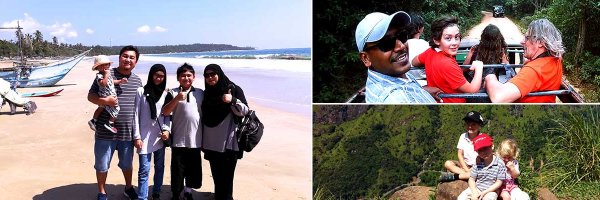
Pahiyangala, Prehistoric site
- Fa-Hien Lena also referred to as Pahiyangala is an important prehistoric site with the cave that yielded the earliest human remains in Sri Lanka. It is located in Yatigampitiya Village just 5 km from Bulathsinhala and 40 km east of Kalutara. This site is situated at 122 m above mean sea level and the cave is 61 m long. At the entrance, the cave is 53 m in high and 49 m wide. It is the largest cave on the island, and one of the largest in Asia. Archaeologists believed that 3000 people can easily accommodate this cave. The name of this cave has derived from the name of the Chinese Buddhist priest “Fa- Hsien” who lived several months here during his visit to “Sri Pada” in 411 AD.
Former Archaeological Commissioner, Dr. Siran Deraniyagala has uncovered burial sites in this cave during their excavation in 1968. They were able to found human remains, stone tools, and remnants of the fireplace. The carbon dating has confirmed that this cave was occupied about 33,000 years before. The human remains are accredited to 3 children, a young child, and young women. The young child carbon-dated to 6,850 years Before Present (BP) and the young woman to 5,400 years BP.
It is only a 20-minute walk to the cave. You will be able to witness the excavation pit by a walk down the stairs to the cave and explore the digs with your own eyes.
- Fa-Hien Lena also referred to as Pahiyangala is an important prehistoric site with the cave that yielded the earliest human remains in Sri Lanka. It is located in Yatigampitiya Village just 5 km from Bulathsinhala and 40 km east of Kalutara. This site is situated at 122 m above mean sea level and the cave is 61 m long. At the entrance, the cave is 53 m in high and 49 m wide. It is the largest cave on the island, and one of the largest in Asia. Archaeologists believed that 3000 people can easily accommodate this cave. The name of this cave has derived from the name of the Chinese Buddhist priest “Fa- Hsien” who lived several months here during his visit to “Sri Pada” in 411 AD.
Former Archaeological Commissioner, Dr. Siran Deraniyagala has uncovered burial sites in this cave during their excavation in 1968. They were able to found human remains, stone tools, and remnants of the fireplace. The carbon dating has confirmed that this cave was occupied about 33,000 years before. The human remains are accredited to 3 children, a young child, and young women. The young child carbon-dated to 6,850 years Before Present (BP) and the young woman to 5,400 years BP.
It is only a 20-minute walk to the cave. You will be able to witness the excavation pit by a walk down the stairs to the cave and explore the digs with your own eyes.
- Fa-Hien Lena also referred to as Pahiyangala is an important prehistoric site with the cave that yielded the earliest human remains in Sri Lanka. It is located in Yatigampitiya Village just 5 km from Bulathsinhala and 40 km east of Kalutara. This site is situated at 122 m above mean sea level and the cave is 61 m long. At the entrance, the cave is 53 m in high and 49 m wide. It is the largest cave on the island, and one of the largest in Asia. Archaeologists believed that 3000 people can easily accommodate this cave. The name of this cave has derived from the name of the Chinese Buddhist priest “Fa- Hsien” who lived several months here during his visit to “Sri Pada” in 411 AD.
Former Archaeological Commissioner, Dr. Siran Deraniyagala has uncovered burial sites in this cave during their excavation in 1968. They were able to found human remains, stone tools, and remnants of the fireplace. The carbon dating has confirmed that this cave was occupied about 33,000 years before. The human remains are accredited to 3 children, a young child, and young women. The young child carbon-dated to 6,850 years Before Present (BP) and the young woman to 5,400 years BP.
It is only a 20-minute walk to the cave. You will be able to witness the excavation pit by a walk down the stairs to the cave and explore the digs with your own eyes.

 +39 - 39 - 307 6 3730
+39 - 39 - 307 6 3730 +94 - 74 - 000 9208
+94 - 74 - 000 9208


Share this page